Surface area and volume class 9 exercise 13.1 || ncert maths class 9 chapter 13 solutions || class 9 maths chapter 13 exercise 13.1 || class 9 exercise 13.1 || class 9 surface area and volume exercise 13.1
Explore step-by-step solutions for Class 9 Maths Chapter 13, Exercise 13.1, which introduces students to the concept of Surface Areas and Volumes of three-dimensional shapes. This exercise focuses on calculating the surface area of basic solid figures like cubes, cuboids, cylinders and other simple solids using standard formulas. Building on their understanding of two-dimensional geometry, students now transition into 3D space, learning to visualize, measure and analyze real-world objects mathematically. Through these problems, learners strengthen their spatial awareness, improve logical reasoning, and gain practical skills that are essential for more advanced topics in mensuration and applied mathematics.

surface area and volume class 9 exercise 13.1 || ncert maths class 9 chapter 13 solutions || class 9 maths chapter 13 exercise 13.1 || class 9 exercise 13.1 || class 9 surface area and volume exercise 13.1
Exercise 13.1
1. A plastic box 1.5 m long, 1.25 m wide and 65 cm deep is to be
made. It is to be open at the top. Ignoring the thickness of the
plastic sheet, determine:
(i) The area of the sheet required for making the box.
(ii) The cost of sheet for it, if a sheet measuring \( 1 {~m}^{2} \) costs Rs 20
(i) The area of the sheet required for making the box.
(ii) The cost of sheet for it, if a sheet measuring \( 1 {~m}^{2} \) costs Rs 20
Answer
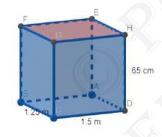
(i) Box is to be open at top (Pink color in the above diagram shows that the box is open)
Method 1:
Lateral Surface Area \( = \) Area of the four sides of the cuboid (Area of four rectangles on the sides)
\( =2 \) (length \(\times\) height) \(+2\) (width \(\times\) height)
Area of sheet required \( = \) lateral Surface Area \(+\) Area of the base
\( =2 {lh}+{2} {bh}+{l b} \)
\(=[2 \times 1.5 \times 0.65+2 \times 1.25 \times 0.65+1.5 \times 1.25] {m}^{2}\)
\(=(1.95+1.625+1.875) {m}^{2}\)
\(=5.45 {~m}^{2}\)
(ii) Cost of sheet per \( {m}^{2} \) area \( = \) Rs 20
Cost of sheet of \( 5.45 {~m}^{2} \) area \( =\operatorname{Rs}(5.45 \times 20) \)
\( = \) Rs 109
Method 2:
(i) Area of Sheet Required \(=\) Total Surface Area \(-\) Area of top
Area of Sheet Required \( =2({lb}+{bh}+{hl})-{lb} \)
Area of sheet Required \( =2 \times 1.5 \times 0.65+2 \times 1.25 \times 0.65+2\) \( \times 1.5 \times 1.25 -1.5 \times 1.25 \)
Area of Sheet Required \( =5.45 {~m}^{2} \)
(ii) Cost of sheet per \( {m}^{2} \) area \( ={Rs} 20 \)
Cost of sheet of \( 5.45 {~m}^{2} \) area \( =\operatorname{Rs}(5.45 \times 20) \)
= Rs 109
Hence, the cost of sheet is Rs. 109.
2. The length, breadth and height of a room are \( 5 {~m}, 4 {~m}
\) and 3 m respectively. Find the cost of white washing the walls
of the room and the ceiling at the rate of Rs 7.50 per \( {m}^{2}
\).
Answer
Given: Length \( =5 {~m} \), Breadth \( =4 {~m} \), and Height \(
=3 {~m} \) Diagram:
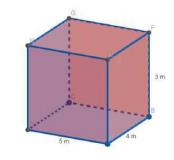
It can be observed that four walls and the ceiling of the room are to be whitewashed.
The floor of the room is not to be white-washed
The area to be white-washed \( = \) Area of walls \(+\) Area of the ceiling of the room
\(=2 {l} {h}+2 {bh}+{lb}\)
\(=[2 \times 5 \times 3+2 \times 4 \times 3+5 \times 4] {m}^{2}\)
\(=(30+24+20) {m}^{2}\)
\(=74 \ {m}^{2}\)
Cost of white-washing per \( {m}^{2} \) area \( = \) Rs 7.50
Cost of white-washing \( 74 {~m}^{2} \) area \( =\operatorname{Rs}(74 \times 7.50) \)
\(\text {= Rs } 555\)
3. The floor of a rectangular hall has a perimeter 250 m. If the
cost of painting the four walls at the rate of Rs 10 per \(
{m}^{2} \) is Rs 15000, find the height of the hall.
Answer
Given: Perimeter of the floor of hall \( =250 {~m} \), cost of
painting the four walls \(=\) Rs. 15,000To Find: Height of the hall
Let length, breadth, and height of the rectangular hall be \( {l ~m}, {~b} {~m} \), and \( {h ~m}\) respectively.
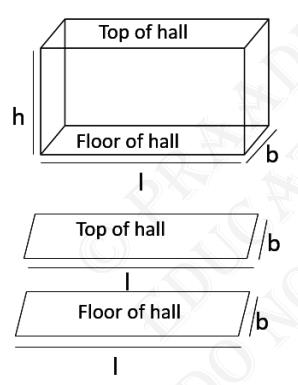
Area of four walls \( ={2 l h}+{2 b h}=2(l+b) h \)
Perimeter of the floor of hall \( =2(l+b) \)
Perimeter of the floor of hall \( =250 {~m} \)
Therefore, \( 2(l+b)=250 {~m} \)
Putting this value in the formula of Area of four walls we get,
Area of four walls \( =2(l+b) h \)
Area of four walls \( =250 {~h} {m}^{2} \)
Cost of painting per \( {m}^{2} \) area \( = \) Rs 10
Cost of painting \( 250 {~h} {~m}^{2} \) area \( ={Rs}(250 {~h} \times 10) \)
\(=\text {Rs } 2500 {~h}\)
However, it is given that the cost of painting the walls is Rs 15000
\( 15000=2500 h \)
\({h}=\frac{15000}{2500}\)
\({h}=\frac{150}{25}\)
\({h}=6\)
Therefore, the height of the hall is 6 m
surface area and volume class 9 exercise 13.1 || ncert maths class 9 chapter 13 solutions || class 9 maths chapter 13 exercise 13.1 || class 9 exercise 13.1 || class 9 surface area and volume exercise 13.1
4. The paint in a certain container is sufficient to paint an
area equal to \( 9.375 {~m}^{2} \) How many bricks of dimensions
\( 22.5 {~cm} \times 10 {~cm} \times 7.5 \) cm can be painted out
of this container?
Answer
The dimensions of the brick are:\({l}=22.5 {~cm}\)
\({b}=10 {~cm}\)
\({h}=7.5 {~cm}\)
Total surface area of one brick \( =2({lb}+{bh}+{lh}) \)
\(=[2(22.5 \times 10+10 \times 7.5+22.5 \times 7.5)] {cm}^{2}\)
\(=2(225+75+168.75) {cm}^{2}\)
\(=(2 \times 468.75) {cm}^{2}\)
\( =937.5 {~cm}^{2} \)
Area that can be painted by the paint of the container \( =9.375 {~m}^{2} \)
As \( 1 {~m} ^{2}=10000 {~cm}^{2} \)
\(=93750 {~cm}^{2}\)
No. of bricks \( =\frac{\text { Area that can be painted }}{\text { Surface are of brick }} \)
\(=\frac{93750}{937.5}\)
\(=100\)
Therefore, 100 bricks can be painted out by the paint of the container.
5. A cubical box has each edge 10 cm and another cuboidal box is
12.5 cm long, 10 cm wide and 8 cm high.
(i) Which box has the greater lateral surface area and by how much?
(ii) Which box has the smaller total surface area and by how much?
(i) Which box has the greater lateral surface area and by how much?
(ii) Which box has the smaller total surface area and by how much?
Answer
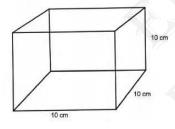
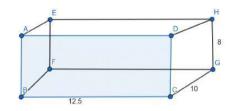
(i) Edge of cube \( =10 {~cm} \)
Length (l) of box \( =12.5 {~cm} \)
Breadth (b) of box \( =10 {~cm} \)
Height (h) of box \( =8 {~cm} \)
Lateral surface area (Cubical box) \( =4(\text {edge})^{2} \)
\(=4(10 {~cm})^{2}\)
\(=400 {~cm}^{2}\)
Lateral surface area of \((\) Cuboidal box \( )=2[{lh}+{bh}] \)
\(=[2(12.5 \times 8+10 \times 8)] {cm}^{2}\)
\(=(2 \times 180) {cm}^{2}\)
\(=360 {~cm}^{2}\)
Clearly, the lateral surface area of the cubical box is greater than the lateral surface area of the cuboidal box
Lateral surface area of cubical box \(-\) Lateral surface area of cuboidal box \( =400 {~cm}^{2}-360 {~cm}^{2}=40 {~cm}^{2} \)
Therefore, the lateral surface area of the cubical box is greater than the lateral surface area of the cuboidal box by \( 40 {~cm}^{2} \)
(ii) Total surface area of cubical box \( =6(\text {edge})^{2} \)
\(=6(10 {~cm})^{2}\)
\(=600 {~cm}^{2}\)
Total surface area of cuboidal box \( =2[{lh}+{bh}+{lb}] \)
\(=\left[2(12.5 \times 8+10 \times 8+12.5 \times 10] {cm}^{2}\right.\)
\(=610 {~cm}^{2}\)
Clearly, the total surface area of the cubical box is smaller than that of the cuboidal box
Total surface area of cuboidal box \(-\) Total surface area of cubical box
\( =610 {~cm}^{2}-600 {~cm}^{2} \)
\(=10 {~cm}^{2}\)
Therefore, the total surface area of the cubical box is smaller than that of the cuboidal box by \( 10 {~cm}^{2} \)
6. A small indoor greenhouse (herbarium) is made entirely of
glass panes (including base) held together with tape. It is 30 cm
long, 25 cm wide and 25 cm high.
(i) What is the area of the glass?
(ii) How much of tape is needed for all the 12 edges?
(i) What is the area of the glass?
(ii) How much of tape is needed for all the 12 edges?
Answer
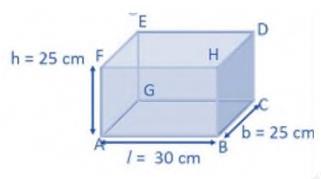
(i) Length (l) of greenhouse \( =30 {~cm} \)
Breadth (b) of greenhouse \( =25 {~cm} \)
Height (h) of greenhouse \( =25 {~cm} \)
Total surface area of green house
\( =2[{lb}+{lh}+{bh}]\)
\(=[2(30 \times 25+30 \times 25+25 \times 25)] {cm}^{2}\)\(=[2(750+750+625)] {cm}^{2}\)
\(=(2 \times 2125) {cm}^{2}\)
\(=4250 {~cm}^{2} \)
Therefore, the area of glass is \( 4250 {~cm}^{2} \)
(ii) It can be observed that tape is required alongside \( {AB}, {BC}, {CD}, {DA} , {EF}, {FG}, {GH}, {HE}, {AH}, {BE}, {DG}, \text{and } {CF}\)
Total length of tape \( =4(l+b+h) \)
\( =[4(30+25+25)] {cm}\)
\(=320 {~cm} \)
Therefore, 320 cm tape is required for all the 12 edges
7. Shanti Sweets Stall was placing an order for making cardboard
boxes for packing their sweets. Two sizes of boxes were required.
The bigger of dimensions \( 25 {~cm} \times 20 {~cm} \times 5
{~cm} \) and the smaller of dimensions \( 15 {~cm} \times 12 {~cm}
\times 5 {~cm} \) for all the overlaps, \( 5 \% \) of the total
surface area is required extra. If the cost of the cardboard is Rs
4 for 1000 \( {cm}^{2} \), find the cost of cardboard required for
supplying 250 boxes of each kind
Answer

We know total surface area of cuboid \( =2({lb}+{lh}+{bh}) \)
For bigger box
Length of bigger box \( =25 {~cm} \)
Breadth of bigger box \( =20 {~cm} \)
Height of bigger box \( =5 {~cm} \)
Total surface area of bigger box \( =2({lb}+{lh}+{bh}) \)
\( =[2(25 \times 20+25 \times 5+20 \times 5)] {cm}^{2}\)
\(=[2(500+125+100)] {cm}^{2}\)
\(=1450 {~cm}^{2} \)
Extra area required for overlapping \( =5 \% \) of the total surface area of bigger box
Extra area required for overlapping \( = \)
\(=\frac{1450 \times 5}{100} {~cm}^{2}\)
\(=72.5 {~cm}^{2}\)
While considering all overlaps, total surface area of 1 bigger box \( =(1450 +72.5) \ {cm}^{2}=1522.5 {~cm}^{2} \)
Area of cardboard sheet required for 250 such bigger boxes \( =(1522.5 \times 250 ){cm}^{2} \)
\(=380625 {~cm}^{2}\)
Similarly, total surface area of smaller box
\(=\left[2(15 \times 12+15 \times 5+12 \times 5] {cm}^{2}\right.\)
\(=[2(180+75+60)] {cm}^{2}\)
\(=(2 \times 315) {cm}^{2}\)
\(=630 {~cm}^{2}\)
Therefore, extra area required for overlapping \( =5 \% \) of the total surface area of smaller box
Therefore, extra area required for overlapping \( =\frac{630 \times 5}{100} {~cm}^{2} \)
\(=31.5 {~cm}^{2}\)
Total surface area of 1 smaller box while considering all overlaps \( =(630 +31.5) \ {cm}^{2} \)
\(=661.5 {~cm}^{2}\)
Area of cardboard sheet required for 250 smaller boxes \( =(250 \times 661.5) \) \( {cm}^{2} \)
\(=165375 {~cm}^{2}\)
Total cardboard sheet required
\(=(380625+165375) {cm}^{2}\)
\(=546000 {~cm}^{2}\)
Cost of \( 1000 {~cm}^{2} \) cardboard sheet \( = \) Rs 4
Cost of \( 546000 {~cm}^{2} \) cardboard sheet
\(=\frac{546000 \times 4}{1000}\)
\(=\text { Rs } 2184\)
Therefore, the cost of cardboard sheet required for 250 such boxes of each kind will be Rs 2184
8. Parveen wanted to make a temporary shelter for her car, by
making a box-like structure with tarpaulin that covers all the
four sides and the top of the car (with the front face as a flap
which can be rolled up). Assuming that the stitching margins are
very small, and therefore negligible, how much tarpaulin would be
required to make the shelter of height 2.5 m, with base dimensions
\( 4 {~m} \times 3 {~m} \) ?
Answer
Length (l) of shelter \( =4 {~m} \)Breadth (b) of shelter \( =3 {~m} \)
Height (h) of shelter \( =2.5 {~m} \)
Tarpaulin will be required for the top and four wall sides of the shelter
Now the area of tarpaulin \(=\) Area of four sides \(\)+ Area of the top
Area of Tarpaulin required \( =2({lh}+{bh})+{l~b} \)
\(=[2(4 \times 2.5+3 \times 2.5)+4 \times 3] {m}^{2}\)
\(=[2(10+7.5)+12] {m}^{2}\)
\(=47 {~m}^{2}\)
Therefore, \( 47 {~m}^{2} \) Tarpaulin will be required.

